Neuronal Signals
Definitions
Neuronal signals→ Signals are brief changes in the electrical potential difference across the plasma membrane of neurons
Electrical potential difference → Voltage measured in volts (is a force)
All living cells have this across their membranes
This electrical potential difference can be used to generate signals– brief changes in voltage across the membrane.
Resistance → The property of the circuit that opposes the movement of charge
Current → The rate of movement of charge
Action potentials → all or none signals that propagate long distances regeneratively
The all or none principle of an action potential means that when a stimulus is strong enough to induce an action potential increasing the strength of the stimulus will not make for a larger action potential. The size of an action potential is fixed
Postsynaptic potentials → graded, local signals
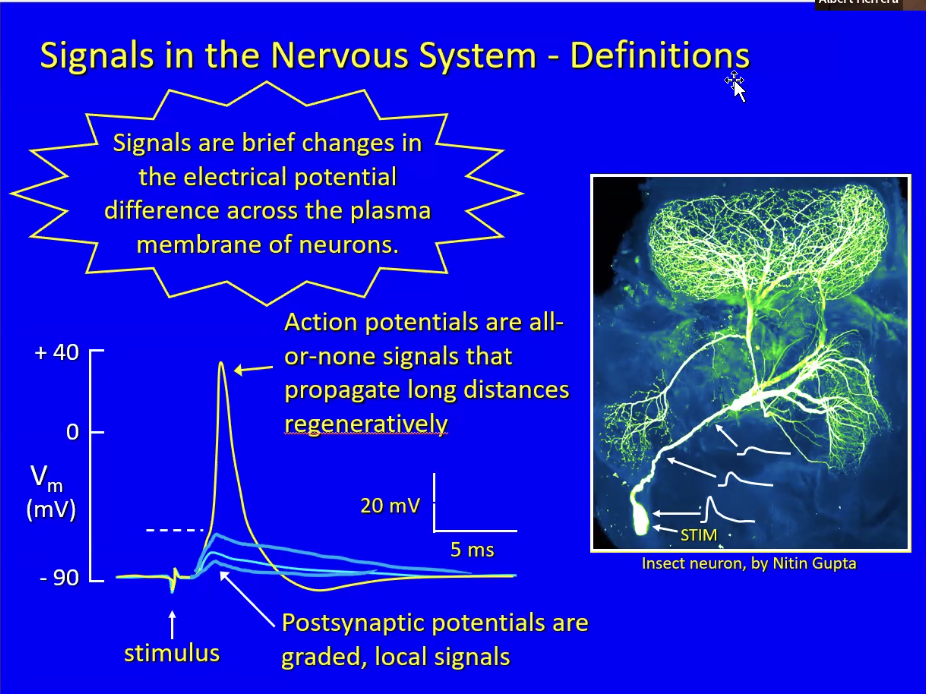
In the graph the resting membrane potential difference is -90 millivolts, meaning that the inside of the cell is 90 millivolts more negative than the outside of the cell
Can range from -90mV to +40mV, which is large for the human cells’ needs
In order to for an action potential to be activated, it must be stimulated, which is represented by the first blip on the graph
Stimuluses can vary in strength
The blue lines on the graph represent different trials with different stimuluses
A small stimulus will produce the line with the most negative voltage (bottom)
A slightly stronger stimulus will produce the line with a slightly more positive voltage (middle)
A stronger stimulus will produce the line with a more positive voltage (top)
Most of the signals in our brains are just little depolarizations from -85mV to -90mV
Signals are locally graded, according to the strength of the stimulus
Graded → Vary with amplitude of stimulus
Local → Means the response is strongest in close proximity to the location of stimulus. If we go further away from the same stimulus, the amplitude gets smaller exponentially
An example is postsynaptic potentials
The strongest of the stimuli will give a depolarization
When the stimulus is strong enough to produce an action potential, that means that passes a threshold/critical point. After the point, the cell rapidly depolarizes and becomes less negative, passes 0 V, and rises to positive 40 mV before dropping back down, either undershooting below the resting membrane potential (hyperpolarization) or dropping to the resting potential.
This is an action potential
Action potentials have the ability to regenerate themselves as the travel throughout the cell
If you step on a lego, the amplitude of the action potential on your foot sole will be the same as the amplitude in your leg and spinal cord as the signal travels because it regenerates as it travels.
Ionic Basis of the Membrane Potential (Vm)
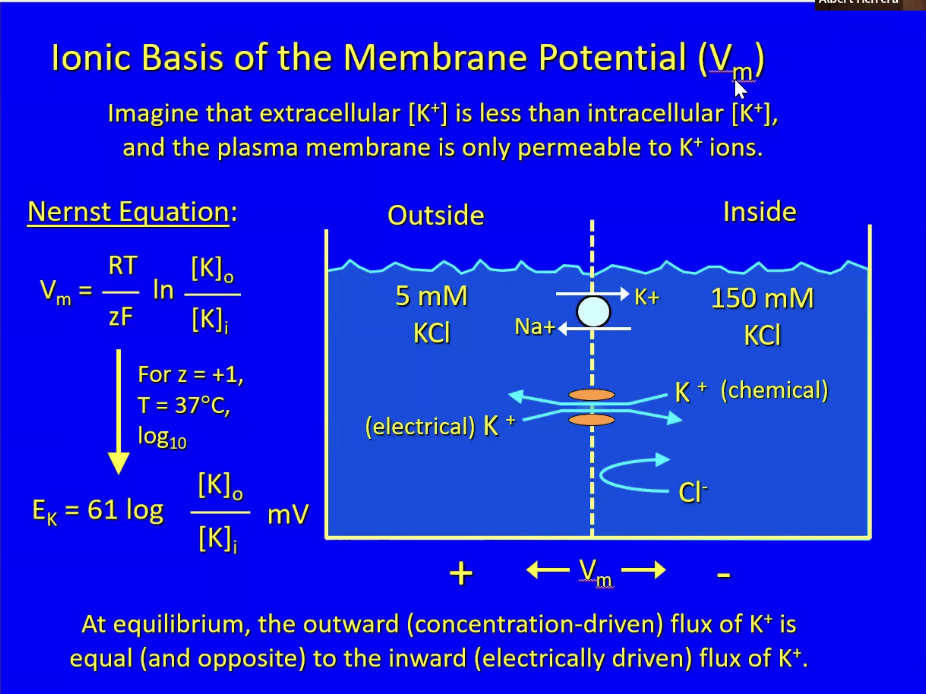
Imagine two chambers separated by a membrane– this is a model of a cell. The left side is outside and the right side is inside.
The inside of your cell has high potassium and low sodium due to the sodium potassium pump
The outside of your cell (extracellular fluid) has low potassium and high sodium (as a result of the kidney’s function and the sodium potassium pumps in our cells)
To remember why cells have high sodium outside the cell, remember that the first cells evolved in the salty ocean!
The cell membrane has a hydrophobic anterior so ions can’t cross it. There is a potassium ion channel that sits in the membrane and has a pore that allows for potassium ions to diffuse. Thus, if there is a gradient, then potassium flows down that gradient.
Thus, potassium flows outside the cell but chloride is left behind this is what makes the cell negative
Say there is a flow of potassium.
We start with 5 mM [K] and [Cl] outside the cell in equal amounts
We start with 150 mM [K] and [Cl] inside the cell in equal amounts
When we introduce the potassium channel, there is a concentration gradient that pushes potassium ions out of the cell. However, for every potassium ion that diffuses out of the cell, there is one chloride anion that remains in the cell, as the potassium channel is impermeable to chloride. This excess of chloride ions makes the cell negative. This attracts the potassium ions back into the cell via an electrical gradient, so there is an equal flow of potassium ions back into the cell through the potassium channel at around -90 mV
The flow of potassium into the cell is driven by an electrical gradient
is proof for Nernst equation
So, if the membrane were ONLY PERMEABLE TO POTASSIUM, the membrane potential would be -90 mV (resting potential)
An equilibrium is reached wherein the flow of potassium outwards (to the left) is equal to the inward electrically driven flow of potassium.
Several Ions and Channels Affect Vm
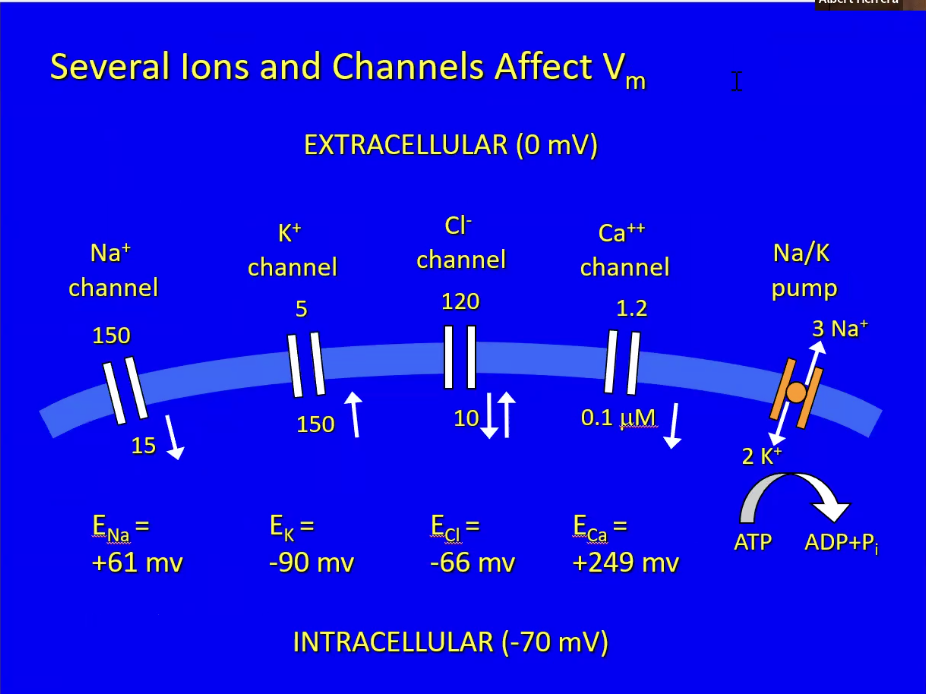
The blue arc represents the nerve cell membrane
There are 4 total channels that control ion concentration in the cell
Sodium selective channels: Allow sodium ions to flow into the cell, contributing to depolarization during action potentials.
150 mM Na outside
15 mM Na inside
Potassium selective channels: Facilitate the exit of potassium ions, which helps return the membrane potential to a resting state after depolarization.
5 mM K outside
150 mM K inside
Calcium selective channels: Enable the influx of calcium ions, important for neurotransmitter release at synapses.
Always a little more than >1 mM Ca+2 outside
Very low– 0.10 to 0.01 uM (micromolar) Ca inside the cell
Chloride selective channels: Regulate chloride ion movement, playing a role in stabilizing the membrane potential.
Approx. ~120 mM outside
Approx. ~10 mM inside
There is also the sodium potassium pump that sends 3 Na+ out and 2 K+ in (recall the mnemonic: 3-2-1 NOKIA). This pump is always working
If the other ions weren’t there and there were only the potassium channel and the sodium potassium pump then it would be the same as last slide with a membrane voltage of -90 mV
What if there were just a sodium channel instead of just a potassium channel ?
If the only open ion channel was sodium, it would be positive inside the cell, maybe +50 mV
In this case, sodium would flow rapidly into the cell due to a chemical gradient, then at equilibrium there will be a flow out of the cell due to an electrical gradient. Keep in mind that at equilibrium there is simultaneous inward and outward flow of sodium at equal rates.
This may also be due to there being high concentrations of chloride left behind outside
An action potential is essentially a combination of these situations
At first, the membrane is only permeable to potassium (-)
Then, the membrane is only permeable to sodium (+)
Finally, the membrane is only permeable to potassium (-)
These channels have gates that can open and close. If the gate is closed its like the channel isnt even there.
What if the membrane has open K and Na channels at the same time?
If the channels have the same permeability for the ions and the ions have the same mobility…
Membrane potential would be around ½ way between the two equilibrium potentials for both sodium and potassium.
However, the permeability is not always equal, so if Na permeability is higher than K, then the potential will be more positive and if K permeability is higher than Na, then the potential will be more negative
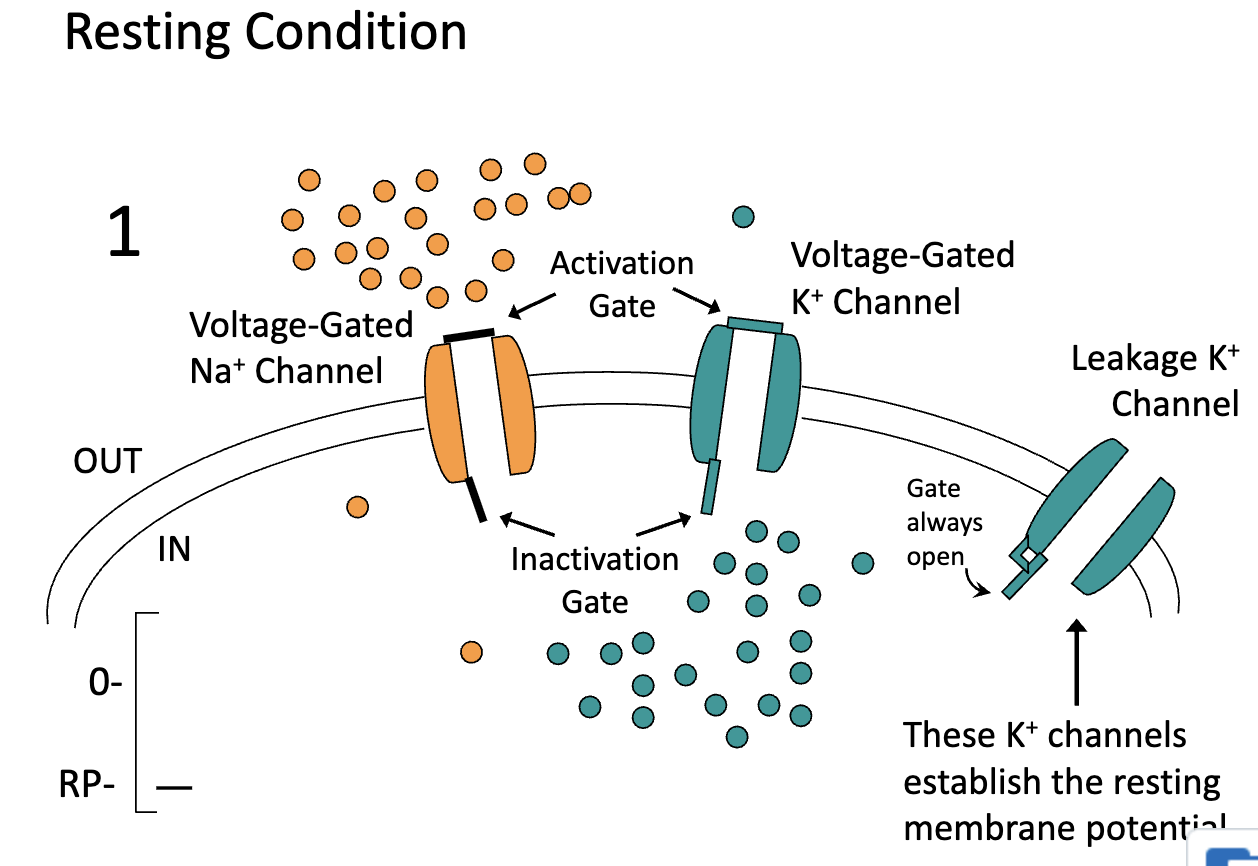
Resting State (Step 1):
Resting potential: –70 mV.
Ion concentrations: High Na⁺ outside, high K⁺ inside.
Channel states:
Voltage-gated Na⁺ channel: Activation gate closed, inactivation gate open (channel is closed).
Voltage-gated K⁺ channel: Activation gate closed, inactivation gate open (channel is closed).
Leaky K⁺ channel: Always open (K⁺ slowly leaks out).
Whether or not a channel is open or closed depends on hydrogen bonds, hydrophobic interactions with lipids, concentration of ions, etc. The shape of the channel proteins, specifically the gates, is dependent on the membrane potential! The gates are highly charged, and are therefore more sensitive to these changes in membrane potential.
When we change potential, the voltage gated channels’ gates change position– either from closed to open or open to closed
The gate is either open or closed, there is no in-between. It happens instantaneously, within around 10^-15 seconds.
Some gates are harder/easier to move than others.

Depolarization Begins (Step 2):
Trigger: A change in voltage opens the activation gate of the Na⁺ channel.
Na⁺ rushes in rapidly due to both chemical and electrical gradients.
This depolarizes the membrane (makes it less negative).
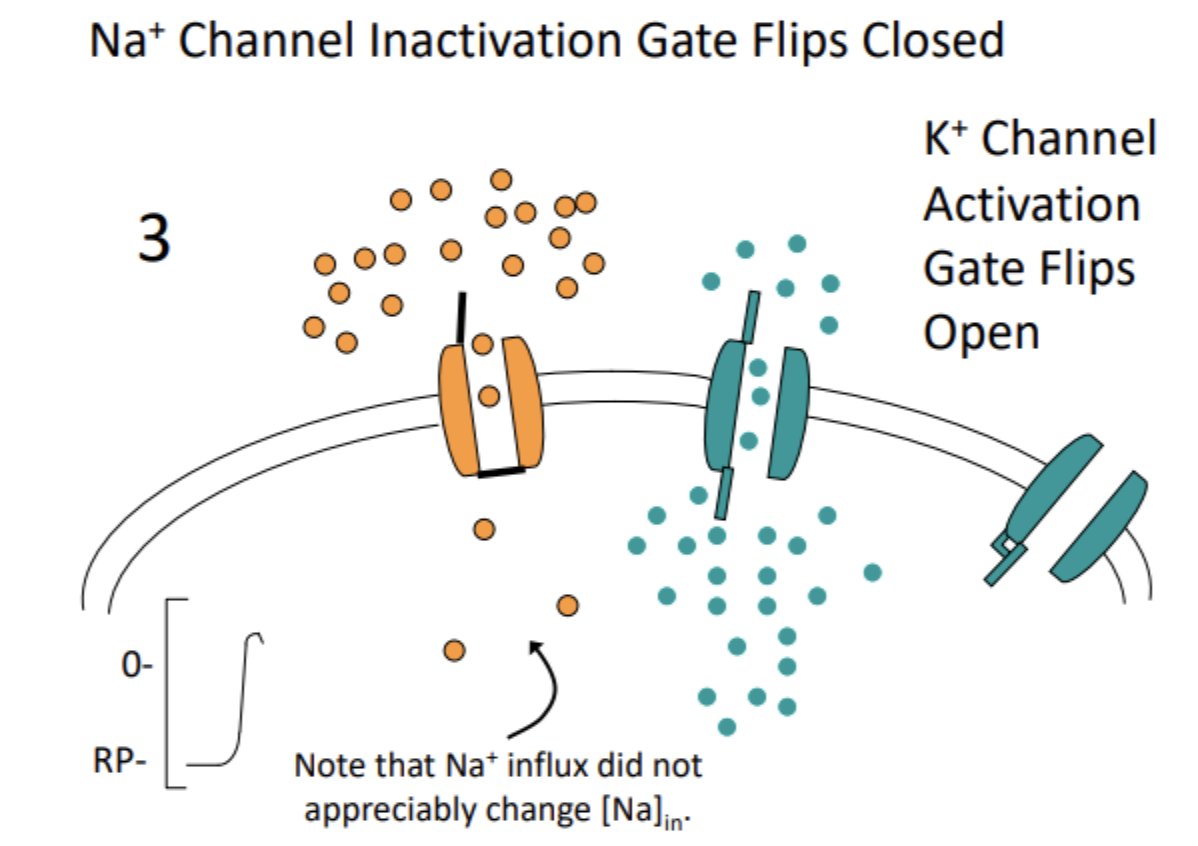
Peak of Action Potential:
Na⁺ channel: Activation gate open, but now inactivation gate closes, stopping Na⁺ inflow.
K⁺ channel: Activation gate opens slowly; K⁺ flows out.
Net effect: Positive charges exit → repolarization starts.
Leak channel is always open
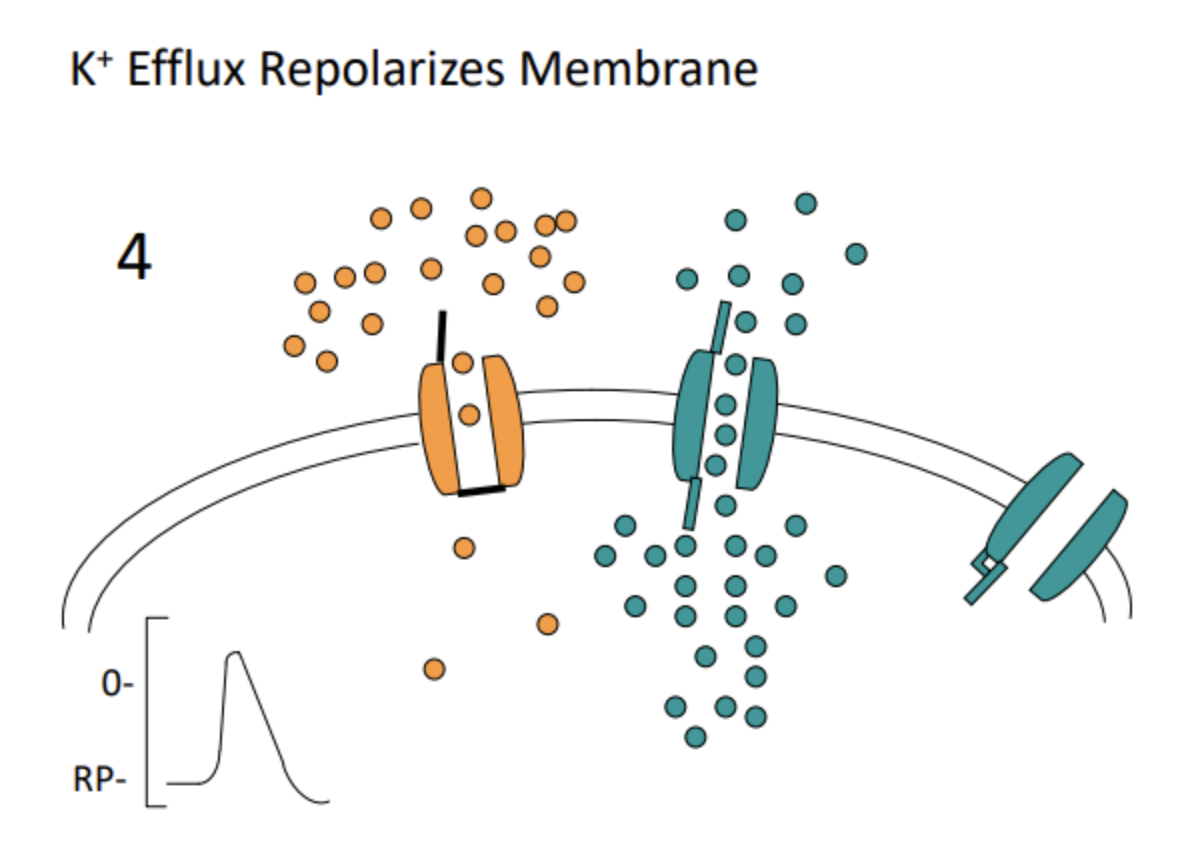
Step 4: Repolarization
Na⁺ channel:
Activation gate: Open
Inactivation gate: Closed
K⁺ channel:
Activation gate: Open
→ K⁺ keeps flowing out
Net result: Membrane potential drops back toward resting.
Leak potassium channel is always open
IN EVERY CASE– IF A POTASSIUM CHANNEL IS OPEN THE NET FLOW OF K IS OUTWARDS BC CONCENTRATION OVERRIDES ELECTRICAL GRADIENT
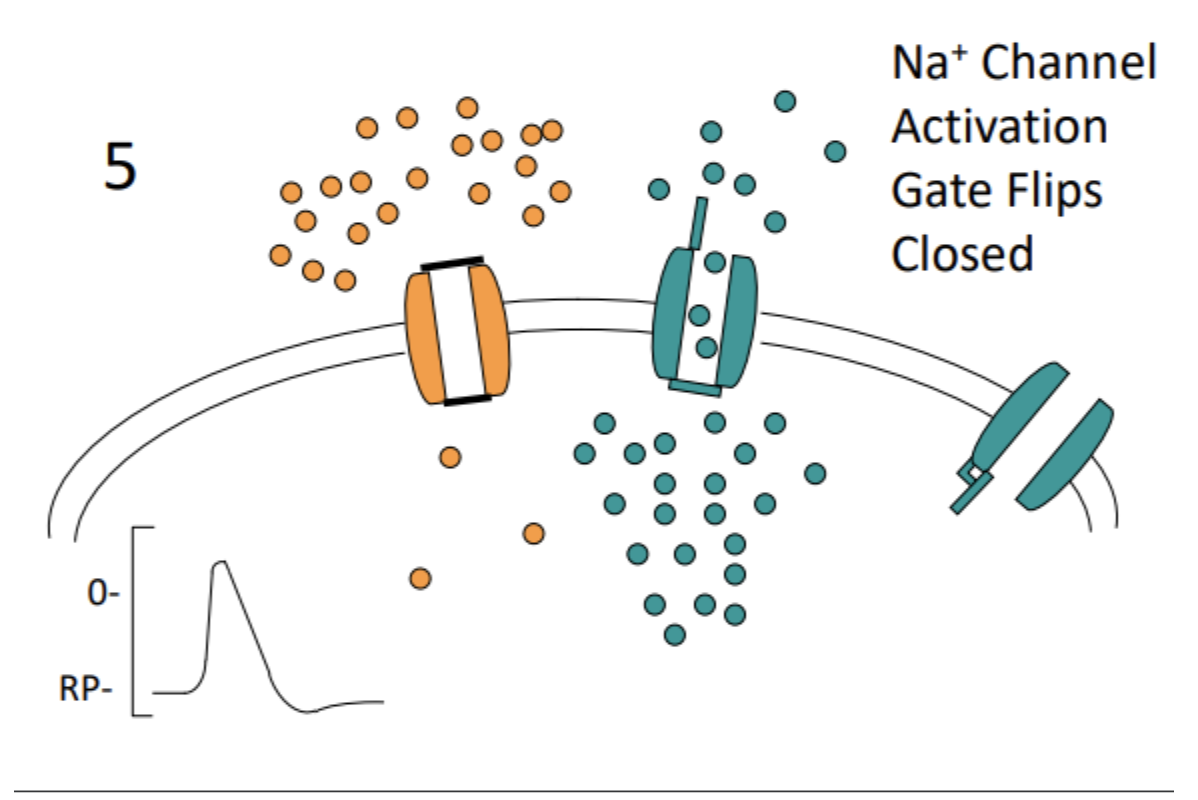
Step 5: Hyperpolarization
K⁺ keeps flowing out, overshooting resting potential.
Na⁺ channel: Still inactivated (both gates not yet reset).
K⁺ channel:
Activation gate: Open
Inactivation gate: Open
Net result: Membrane potential dips below –70 mV.

Return to Resting State:
Na⁺ and K⁺ channels: Both gates closed.
Leaky K⁺ channel: Still open.
Sodium-potassium pump (Na⁺/K⁺-ATPase) restores ion gradients using ATP.
Glial cells assist by taking up excess K⁺ from extracellular space.
Pumping potassium ions out doesnt affect the external concentration, as the volume of the bulk solution is too high.